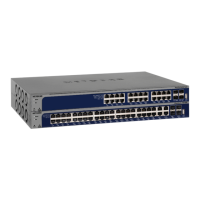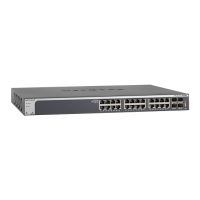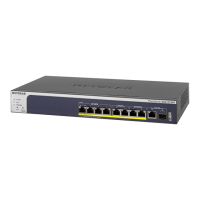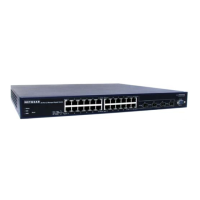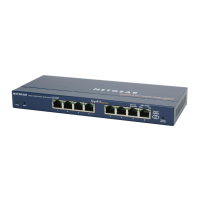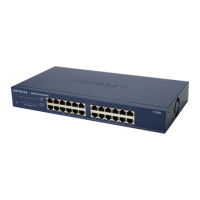Configure Quality of Service
256
XS708T, XS712Tv2, and XS716T Smart Managed Pro Switch User Manual
• Mark IP Precedence. Select this radio button to require packets to be marked with an
IP precedence value before being forwarded. You must select an IP precedence
value from 0 to 7 from the menu.
• Mirror. Select this radio button to require packets to be mirrored to an interface or
LAG, one of which you must select from the menu.
• Redirect. Select this radio button to require packets to be redirected to an interface or
LAG, one of which you must select from the menu.
• Mark IP DSCP. Select this radio button to require packet to be marked with an IP
DSCP keyword code, which you must select from the menu. The menu includes
Other as a selection, which lets you enter an IP DSCP value from 0 to 63. The DSCP
value is defined as the high-order 6 bits of the Service Type octet in the IP header.
• Simple Policy. Select this radio button to define the traffic policing style for the class.
A simple policy uses a single data rate and burst size, resulting in one of two
outcomes: conform or violate. You must define the policy as described in the next
step.
12. If you select the Simple Policy radio button, you can specify the traffic policing style for the
class:
• Color Mode. From the menu, select one of the following options:
- Color Blind. This is the default selection. Color classes do not apply.
- Color Aware. Requires you to select a color class that is valid for use with this
policy instance. After you select Color Aware from the Color Mode menu, the
Color Conform Class menu displays. From this menu you must select a color
class that you already created (see Configure a DiffServ Class on page 243) and
selected as a member class for this policy instance (see Step 7).
Note: A valid color class contains a single, non-excluded match criterion for the
CoS, IP DSCP, or IP Precedence option. The configured option must not
conflict with the classifier of the policy instance itself.
• Committed Rate. Enter the committed rate that is applied to conforming packets by
specifying a value in the range from 1 to 4294967295 Kbps.
• Committed Burst Size. Enter the committed burst size that is applied to conforming
packets by specifying a value in the range from 1 to 128 Kbps.
13. Select the conforming and violating actions.
The Conform Action section and Violate Action section list the actions to be taken on
conforming packets according to the policing metrics. By default, both conforming
packets and violating packets are sent.
In both the Conform Action section and the Violate Action section, select one of the
following actions:
• Send. Packets are forwarded unmodified. This is the default confirming action and the
default violating action.
• Drop. Packets are dropped.

